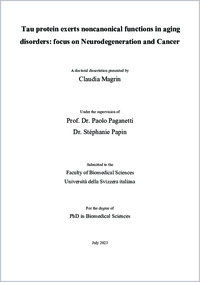Tau protein exerts noncanonical functions in aging disorders : focus on neurodegeneration and cancer
- Magrin, Claudia
- Paganetti, Paolo (Degree supervisor)
- Papin, Stéphanie (Degree supervisor)
- 2023
PhD: Università della Svizzera italiana
Neurodegeneration
Cancer
Aging
Tau
DNA damage
P53
Apoptosis
Epigenetic
PRC2
EZH2
H3K27me3
IGFBP3
Senescence
English
Tau protein has been extensively studied in the context of its role in microtubule stabilization. However, recent evidence suggests that Tau might also exert noncanonical functions beyond its well-known cytoskeletal role. Recent studies have shown that a fraction of Tau protein can translocate into the nucleus. However, the functional significance of Tau's nuclear presence remains largely unexplored. The hypothesis of this study is that the protein Tau exerts noncanonical functions by modulating chromatin maintenance. In particular, we propose to investigate whether Tau plays a central role in modulating chromatin maintenance within the nucleus. We hypothesize that Tau may interact with chromatin-associated proteins and epigenetic regulators, influencing chromatin structure, transcriptional regulation, and ultimately impacting cellular homeostasis. Understanding the potential noncanonical functions of Tau in chromatin maintenance might unveil new regulatory mechanisms and could shed light on novel therapeutic strategies for neuro- degenerative diseases and other conditions where chromatin dysregulation is implicated. To test our hypothesis, we decided for the following experimental approaches: The first part of my PhD project focused on investigating whether a loss-of-function of Tau may contribute to the regulation of the DDR, possibly impacting on human disorders associated with aging. In fact, the accumulation of DNA damage is one of the main hallmarks of aging and it represents a risk factor for aging-related diseases such as cancer and neurodegeneration. Thus, we first generated and characterized neuroblastoma cell lines knocked-out or knocked-down for Tau. Then, we induced an acute DNA damage, and we compared the DDR in Tau-expressing and Tau-depleted cells. The data collected demonstrated that the depletion of Tau in cells had little impact on the first steps of the DDR but had a dramatic effect on the stability of p53 and its activity as the key factor balancing the induction of apoptosis and senescence. Strikingly, this regulatory function of Tau was clearly exposed when the cells were subjected to an acute DNA damage. However, we observed that Tau knockout cells displayed a tendency to enter a senescent status. The second part of the thesis assessed whether senescence induction in Tau knockout cells was due to an epigenetic-mediated transcriptional program. For this, we performed a transcriptome analysis obtained from the comparison between neuroblastoma cell lines expressing Tau or knocked-out for Tau. We then questioned the transcriptome data for a bioinformatic analysis aim at identifying a mechanism activated by Tau-depletion and possibly involved in the induction of senescence. Among the transcripts deregulated in a Tau-dependent manner, we found an enrichment of target genes for the PRC2. we then analyzed the PRC2 core components and its activity in our cellular model. We found a decreased level of the core components of the PRC2 complex and a lower H3K27 methylation activity in Tau deficient cells. Moreover, IGFBP3, a specific target gene of PRC2 involved in senescence was increased in Tau deficient cells we provided evidence that increased senescence in Tau knockout cells is due to decreased repression of IGFBP3 expression by PRC2. Considering the unmet medical need with heavy personal and economic impact, the understanding of the molecular mechanism and the cellular bases of these disorders offers a great hope for the future.
- Collections
- Language
-
- English
- Classification
- Medicine
- License
-
License undefined
- Open access status
- green
- Identifiers
-
- NDP-USI 2023BIOMED002
- URN urn:nbn:ch:rero-006-121164
- ARK ark:/12658/srd1325968
- Persistent URL
- https://n2t.net/ark:/12658/srd1325968
Statistics
Document views: 239
File downloads:
- 2023BIOMED002: 485
